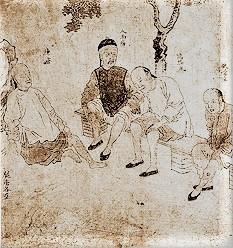Specific Details on Swelling, Pain, Itching and Pus Formation
In Western medicine, the microscopic investigation of septic infections and skin ulcers needs to be carried and before appropriate treatment can commence, however TCM physicians usually focus on body signs like swelling, pain, itching, and pus formation rather than what kind of microbial contamination is involved.
 TCM holds that the presence of certain symptoms indicates particular internal disharmony, such as
TCM holds that the presence of certain symptoms indicates particular internal disharmony, such as
During a consultation, TCM physicians pay special attention to specific details of a local condition, such as swelling, pain, itching, pus and numbness, as they help determine the appropriate treatment methods and the choice of herbs.
Types of swelling
Swelling indicates blockage in the meridians or stagnated blood or qi flows; however, some influential factors lead to other kinds of manifestations.
| Influential factors | Manifestations |
| Fire | The swelling has burning pain and its surface appears shiny and bright red. |
| Coldness | The swelling is firm and is usually associated with dull pain or a cool feeling; its surface is pale and purple in color and is matte in appearance. |
| Wind | The swelling is diffuse and extensive or shifts constantly. There is mild pain, no redness and the area is slightly hot. |
| Dampness | There can be extensive swelling with pitting or blisters. |
| Phlegm | The swelling is either solid or very soft; it is neither painful nor hot. |
| Blood stasis | There is acute blue-purplish swelling such as that occurs with trauma. |
Types of pain
In external medicine, impaired blood and qi circulation usually cause pain; however, various factors and the regions involved all determine the nature of the pain. For example:
| Influential factors | Manifestations |
| Heat | Burning pain that can be relieved by cooling; the surface area is bright red. |
| Cold | Dull pain that can be relieved by warming; there is no redness or heat. |
| Wind | The pain tends to be always moving and changing. |
| Blood stasis | Distending or stabbing pain with bruising. |
Types of itching
In TCM, itching usually arises from a disturbance in pathogens accumulated in the superficial muscles or on the skin. There can be a single or multiple pathogens, exogenous or endogenous.
| Influential factors | Manifestations |
| Wind dominating | The itching constantly moves around the body; dry marks appear on the skin. |
| Dampness dominating | Itchiness with a secretion; the more eroded the area, the more severe the itch. |
| Heat dominating | Skin rash associated with itchiness and a hot sensation; in severe cases, there may be scabs and a secretion. |
| Blood deficiency | Itchiness associated with dryness, thickness and peeling. |
Type of pus formation
TCM believes that pus is the end product of excessive heat accumulation and tissue decay, and that blood and qi stagnation facilitate its formation. Thus, the nature of pus provides crucial information about the progress of a condition.
| Texture | Thick and sticky pus indicates inborn qi is in abundance, while thin and watery pus indicates insufficiency. If yellow pus changes gradually from turbid to clear with a thick discharge, then it is a favorable sign. If thick and sticky pus turns thin and watery, it is a sign of bodily deterioration, which does not favor wound healing. If pus is thin, turbid and milky or contains decayed tissue and is foul smelling, then it is a poor sign. |
| Color | Bright, white-yellow thick pus indicates that blood and qi are abundant; dirty yellow thick pus means there is still resistance; thin and clear yellow pus means resistance is very weak. If the pus is darkish-green, thin and watery, that means it is a chronic wound and there may be bone and tendon damage. |
| Odor | Thick pus with a mild fishy smell indicates favorable progress, while foul and watery pus indicates unfavorable progress. |


